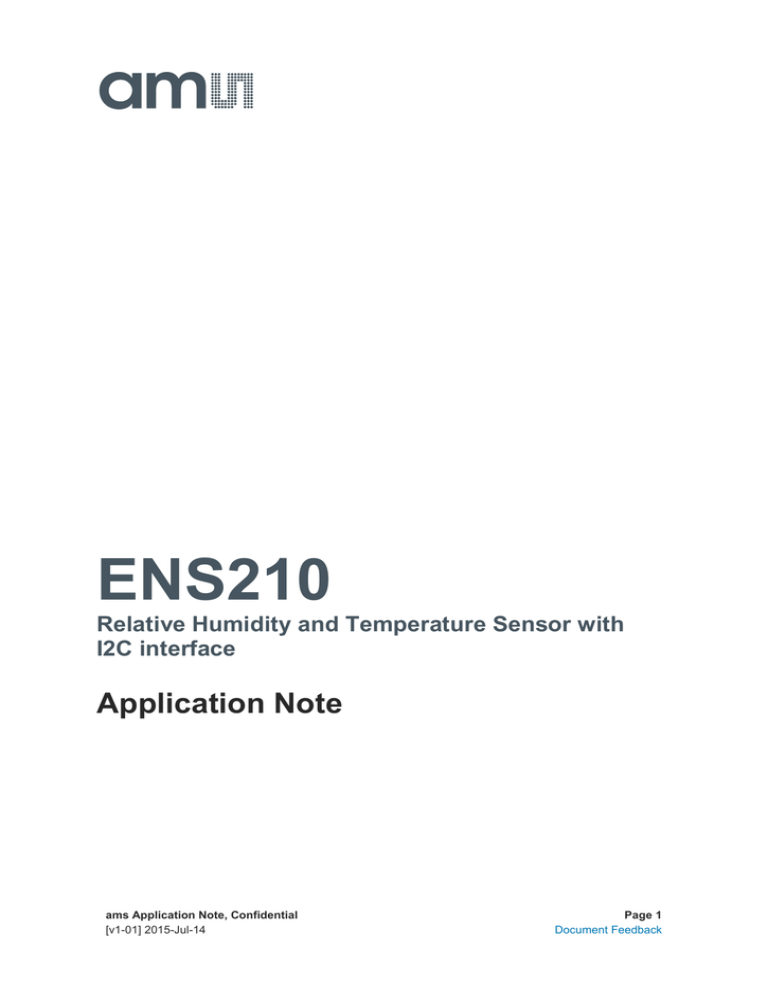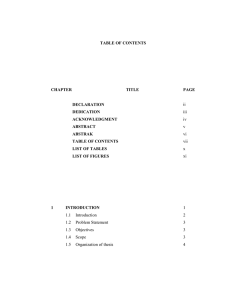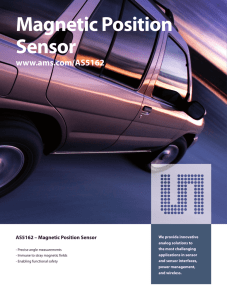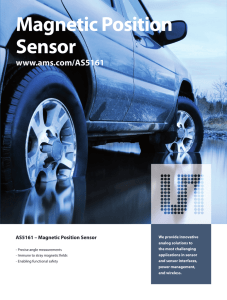
DN[Document ID]
ENS210
Relative Humidity and Temperature Sensor with
I2C interface
Application Note
ams Application Note, Confidential
[v1-01] 2015-Jul-14
Page 1
Document Feedback
ENS210 Relative Humidity and Temperature Sensor with I2C interface
Content Guide
1
General Description ............................................................................................................. 3
2
Sensing Modality .................................................................................................................. 3
3
Circuit Design Consideration ............................................................................................... 3
4
PCB Layout Consideration ................................................................................................... 4
5
Casing Design Consideration .............................................................................................. 5
6
ENS210 Handling................................................................................................................. 7
7
Low Power Design ............................................................................................................... 8
8
Summary .............................................................................................................................. 8
9
Reference ............................................................................................................................. 8
10
Ordering & Contact Information ........................................................................................... 9
11
Copyrights & Disclaimer ..................................................................................................... 10
12
Revision Information .......................................................................................................... 11
Figure Guide
Figure 1 – Recommended Application Circuit ..................................................................................... 4
Figure 2 – General Guideline for ENS210 PCB Layout ...................................................................... 4
Figure 3 – ENS210 Decoupling ........................................................................................................... 5
Figure 4 – General Guideline for ENS210 Casing Design Consideration ........................................... 6
Figure 5 – General Guideline for ENS210 Chimney Design Consideration ........................................ 7
Figure 6 – Plastic Overhang with Vertical Milling Slits at the Top ....................................................... 7
ams Application Note, Confidential
[v1-01] 2015-Jul-14
Page 2
Document Feedback
ENS210 Relative Humidity and Temperature Sensor with I2C interface
1
General Description
ENS210 is a relative humidity and temperature sensor with I2C interface. It is encapsulated in a
HWSON4 package. This document describes the application design considerations of ENS210 for
measuring relative humidity and temperature. ENS210 is a high sensitivity sensor designed to sense
accurate relative humidity and temperature. To benefit from the high accuracy sensor, the design
considerations in this application note are recommended for accurate and reliable operation of
ENS210.
2
Sensing Modality
Temperature Sensing is the measurement of degree or intensity of heat present in a substance or
object. In order to obtain accurate measurement of temperature, the mode of heat transfer has to be
understood. In temperature measurement, the important modes of heat transfer includes Conduction,
Convection and Radiation. For example, in conduction, a warmer body influence temperature
measurement when it comes into thermal contact to the zone of detection. In convection, warmer fluid
comes into contact with the sensor influencing the measurement. In radiation, heat is transferred from
exposure to light source, such as sunlight, resulting in heating up of the sensor. Nevertheless, it is
important to identify the subject to be measured.
In the case of environmental temperature sensors, the ambient temperature is the most-common
subject of interested, less so is the temperature of its PCB or its casing. During a change in
temperature, readings of the sensor takes some time before it eventually shows a stabilized ambient
temperature. The thermal mass of the sensor and the PCB (e.g. thickness of PCB, amount of solder
used) it is mounted on affects the response time of the readings. In any case the ENS210 should
have direct access to the environment for accurate relative humidity and temperature measurement.
In environmental sensing of relative humidity, ambient temperature influences the measured
readings, less so is the minute changes in atmospheric pressure. Therefore, recommendations for
accurate measurement of relative humidity is similar to that for accurate measurement of temperature.
In the chapters that follows, considerations and recommendations are made to minimize the
undesirable thermal influence due to conduction from parasitic heating (by microprocessor, regulators
or other components), convention due to mechanism enclosure, influences from sunlight due to
exposure to radiation, and to reduce thermal mass of the PCB on which the sensor is mounted on.
3
Circuit Design Consideration
The typical application is showing in figure 1, and the 0.1𝛍F decoupling capacitor is positioned as
close to ENS210 as possible. The host can be either an MCU or other type of I2C master device.
Note that it’s not allowed to tie the VDD pin of the IC to ground or floating the pin when SCL pin and
SDA pin of ENS210 is active, since this may damage the IC. The pull up resistors of the I2C bus
should be placed close to the host. Refer to the chapter 7 of user manual [UM10204] for more details
of the subject of pull up resistor sizing.
ams Application Note, Confidential
[v1-01] 2015-Jul-14
Page 3
Document Feedback
ENS210 Relative Humidity and Temperature Sensor with I2C interface
Figure 1 – Recommended Application Circuit
The operating voltage range of ENS210 is from 1.71V to 3.60V. If the power supply of the host in
figure 1 is out of the range, e.g. 5V or 1.2V, a level shifter should be added between the host and
ENS210.
4
PCB Layout Consideration
Heat conduction occurs mostly over PCB, especially through the metallic ground plane. To minimize
interference to temperature measurement, the following PCB layout guidelines as shown in figure 2
are recommended:
Figure 2 – General Guideline for ENS210 PCB Layout
1.
Place the sensor on the PCB as far as possible from any heat source such as voltage
convertors or LCD backlights to reduce heat conduction from heat sources through PCB.
2.
Put milling slits around the sensor to reduce heat conduction from heat sources.
3.
Use thin PCB traces to interface with sensor to reduce heat conduction through the traces.
4.
Avoid using metallic (e.g. copper) ground plane underneath the sensor to reduce heat
conduction through ground plane.
ams Application Note, Confidential
[v1-01] 2015-Jul-14
Page 4
Document Feedback
ENS210 Relative Humidity and Temperature Sensor with I2C interface
5.
Place the decoupling capacitor as close to sensor as possible. Generally speaking, noise
caused by other circuit elements, e.g. switch, is shunted through the capacitor. In order to
achieve the best performance of this function of the capacitor, it requires to place the
decoupling capacitor as close to the sensor as possible. Figure 3 shows the decoupling
capacitor of ENS210.
6.
In pin arrangement to reduce the crosstalk and interference between clock line and data line
of I2C, the order of I2C interface tracks is suggested as shown in figure 3. This arrangement
reduces bus noise especially when traces are long, e.g. exceeds 10cm.
Figure 3 – ENS210 Decoupling
5
Casing Design Consideration
In designing of casing, the following precautions are advised to minimize heat conduction and
convention from heat source within the casing, and to maximize exposure to environment. Figure 4
describes the general casing design guidelines.
ams Application Note, Confidential
[v1-01] 2015-Jul-14
Page 5
Document Feedback
ENS210 Relative Humidity and Temperature Sensor with I2C interface
Figure 4 – General Guideline for ENS210 Casing Design Consideration
1.
Use a dedicated sensor compartment with shielding walls around the sensor to isolate the IC
from heat sources further.
2.
Use a hydrophobic membrane that provide direct contact to environment but protect against
contamination like dust and liquids from coming into contact with the sensor. The membrane
shall be secured at the opening on the casing to facilitate air flow while keeping out moisture
and contamination.
3.
Provide milling slits to remove heat from sources such as voltage convertors and LCD
backlight to prevent heated air from building up within the casing as shown in figure 5.
4.
The ENS210 should be placed away from heat sources including direct sunlight, and should
have direct access to the ambient relative humidity and temperature.
5.
Maximize ambient airflow around the sensor to improve transient temperature response time.
6.
Temperature is preferably measured at the front of the casing closest to the ambient relative
humidity and temperature. The ENS210 shall be positioned as far away from the ground or
wall to avoid heat conduction from wall.
7.
If casing is positioned up-right, locate sensor as near to the bottom of the casing as possible
to avoid exposure of airflow convection from heat sources, which is also shown in figure 6.
8.
In general, if dust enters the casing it can potentially contaminate the open cavity of the
ENS210 and affect the accuracy of the Relative Humidity measurement. In order to prevent
this, it is advised to use vertical milling slits at the top of the casing so dust cannot enter
directly from the top. Horizontal milling slits at the bottom can release any collected dust out
of the casing by gravity. In this way the ambient air flow is safe guarded.See figure 5 and
figure 6.
ams Application Note, Confidential
[v1-01] 2015-Jul-14
Page 6
Document Feedback
ENS210 Relative Humidity and Temperature Sensor with I2C interface
Figure 5 – General Guideline for ENS210 Chimney Design Consideration
Figure 6 – Plastic Overhang with Vertical Milling Slits at the Top
6
ENS210 Handling
The following points should be taken into consideration when handling the ENS210.
1.
Avoid use of cleaning agents (e.g. post soldering PCB board wash) on the exposed sensor
area. Water-mark and corrosion to humidity-sensitive polymer causes irreversible drift to
relative humidity measurement.
2.
Avoid use of materials such as glue, soft plastics or wood in the vicinity of the ENS210, since
these materials can absorb or emit moisture. Also out gassing from plastics can damage the
sensor if it exposed for long duration.
3.
Exposure to the corrosive substances (both vapors and liquids) at high concentrations
should be avoided as it can damage the sensor.
4.
Other general guidelines for handling of electronic components applies, e.g. ESD.
ams Application Note, Confidential
[v1-01] 2015-Jul-14
Page 7
Document Feedback
ENS210 Relative Humidity and Temperature Sensor with I2C interface
7
Low Power Design
In some applications, the low power design is important and the following are recommended:
1.
SCL and SDA lines of I2C bus are pull-up to VDD and remains high when idle. Small leakage
current through the SCL and SDA pins of the IC causes power loss through the pull-up
resistors. Therefore, a reasonably high pull-up resistor is recommended which reduces
leakage current, thus reducing power consumption at idle. However, high resistance
compounded with trace capacitance causes clock skew during transmission, reducing the
effective data rate of I2C bus. For effective balance between power consumption and signal
integrity, refer to [UM10204].
2.
Do not unpower the IC when it is not used. The IC has polarity of capacitor and unpowering
the IC will reset the polarity.
8
Summary
This application note discusses the design considerations of ENS210 from circuit design, PCB layout,
casing design and ENS210 handling.
9
[1]
Reference
NXP Semiconductors, 2014, UM10204 --- I2C-bus specification and user manual
http://www.nxp.com/documents/user_manual/UM10204.pdf, 4 April 2014, Rev 6
ams Application Note, Confidential
[v1-01] 2015-Jul-14
Page 8
Document Feedback
ENS210 Relative Humidity and Temperature Sensor with I2C interface
10 Ordering & Contact Information
Ordering Code
Description
tbd
ENS210 Demo Kit Reference Board
Buy our products or get free samples online at:
www.ams.com/ICdirect
Technical Support is available at:
www.ams.com/Technical-Support
Provide feedback about this document at:
www.ams.com/Document-Feedback
For further information and requests, e-mail us at:
ams_sales@ams.com
For sales offices, distributors and representatives, please visit:
www.ams.com/contact
Headquarters
ams AG
Tobelbaderstrasse 30
8141 Unterpremstaetten
Austria, Europe
Tel: +43 (0) 3136 500 0
Website: www.ams.com
ams Application Note, Confidential
[v1-01] 2015-Jul-14
Page 9
Document Feedback
ENS210 Relative Humidity and Temperature Sensor with I2C interface
11 Copyrights & Disclaimer
Copyright ams AG, Tobelbader Strasse 30, 8141 Unterpremstaetten, Austria-Europe. Trademarks
Registered. All rights reserved. The material herein may not be reproduced, adapted, merged,
translated, stored, or used without the prior written consent of the copyright owner.
Information in this document is believed to be accurate and reliable. However, ams AG does not
give any representations or warranties, expressed or implied, as to the accuracy or completeness of
such information and shall have no liability for the consequences of use of such information.
Applications that are described herein are for illustrative purposes only. ams AG makes no
representation or warranty that such applications will be appropriate for the specified use without
further testing or modification. ams AG takes no responsibility for the design, operation and testing
of the applications and end-products as well as assistance with the applications or end-product
designs when using ams AG products. ams AG is not liable for the suitability and fit of ams AG
products in applications and end-products planned.
ams AG shall not be liable to recipient or any third party for any damages, including but not limited
to personal injury, property damage, loss of profits, loss of use, interruption of business or indirect,
special, incidental or consequential damages, of any kind, in connection with or arising out of the
furnishing, performance or use of the technical data or applications described herein. No obligation
or liability to recipient or any third party shall arise or flow out of ams AG rendering of technical or
other services.
ams AG reserves the right to change information in this document at any time and without notice.
ams Application Note, Confidential
[v1-01] 2015-Jul-14
Page 10
Document Feedback
ENS210 Relative Humidity and Temperature Sensor with I2C interface
12 Revision Information
Initial version 1-00
Changes from 1-00 (2014-Jun-26) to current revision 1-01 (2015-Jul-14)
Updated Casing Design Considerations
Page
6
Note: Page numbers for the previous version may differ from page numbers in the current revision.
ams Application Note, Confidential
[v1-01] 2015-Jul-14
Page 11
Document Feedback






